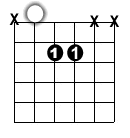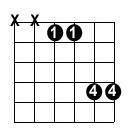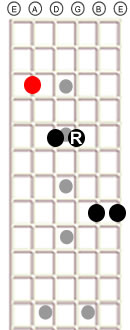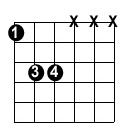6th String Root Power Chord
Below is what the 6th string root power chord looks like in the open position. Played in the open position it’s an E power chord because the root note is the open E string.
Here is its movable pattern:
In the example below, the power chord pattern is played with its root on the 5th fret which is an A note, making this an A power chord.

| Fret | 1 | 2 | 3 | 4 | 5 | 6 | 7 | 8 | 9 | 10 | 11 | 12 |
| Chord | F | F#/Gb | G | G#/Ab | A | A#/Bb | B | C | C#/Db | D | D#/Eb | E |
5th String Root Power Chord
This power chord pattern is similar to the previous pattern, only its root note is now on the A string instead of the low E string.
Below is what the 6th string root power chord looks like in the open position. Played in the open position it’s an A power chord.

Here is its movable pattern:

In the example below, the power chord pattern is played with its root on the 5th fret making it a D power chord.

| Fret | 1 | 2 | 3 | 4 | 5 | 6 | 7 | 8 | 9 | 10 | 11 | 12 |
| Chord | A#/Bb | B | C | C#/Dd | D | D#/Eb | E | F | F#/GB | G | G#/AB | A |
3rd String Root
This pattern is not used as often, either. It’s a little hard to learn and play. The root of this power chord pattern is not the note on the lowest string, but instead, it’s the note played on the G string (3rd string).

You can look at it as an extension of the 5th string root power chord. In the picture below is the 3rd string root power chord pattern with its root marked with an “R”. Now if you cover up the notes at the bottom on the B string and high E string you’ll recognize the 5th string root power chord pattern. The root note to the 5th string root power chord is shown in red. It’s on a C note, so it would be a C power chord. The root of the 3rd string root power chord is also a C note, so it too is a C power chord.

In the audio example below, the power chord pattern is played with its root on the 5th fret making it a C power chord. The picture shows it with its root on the 4th fret, which would be a B power chord.

| Fret | 1 | 2 | 3 | 4 | 5 | 6 | 7 | 8 | 9 | 10 | 11 | 12 |
| Chord | G#/Ab | A | A#/Bb | B | C | C#/Db | D | D#/Eb | E | F | F#/Gb | G |

